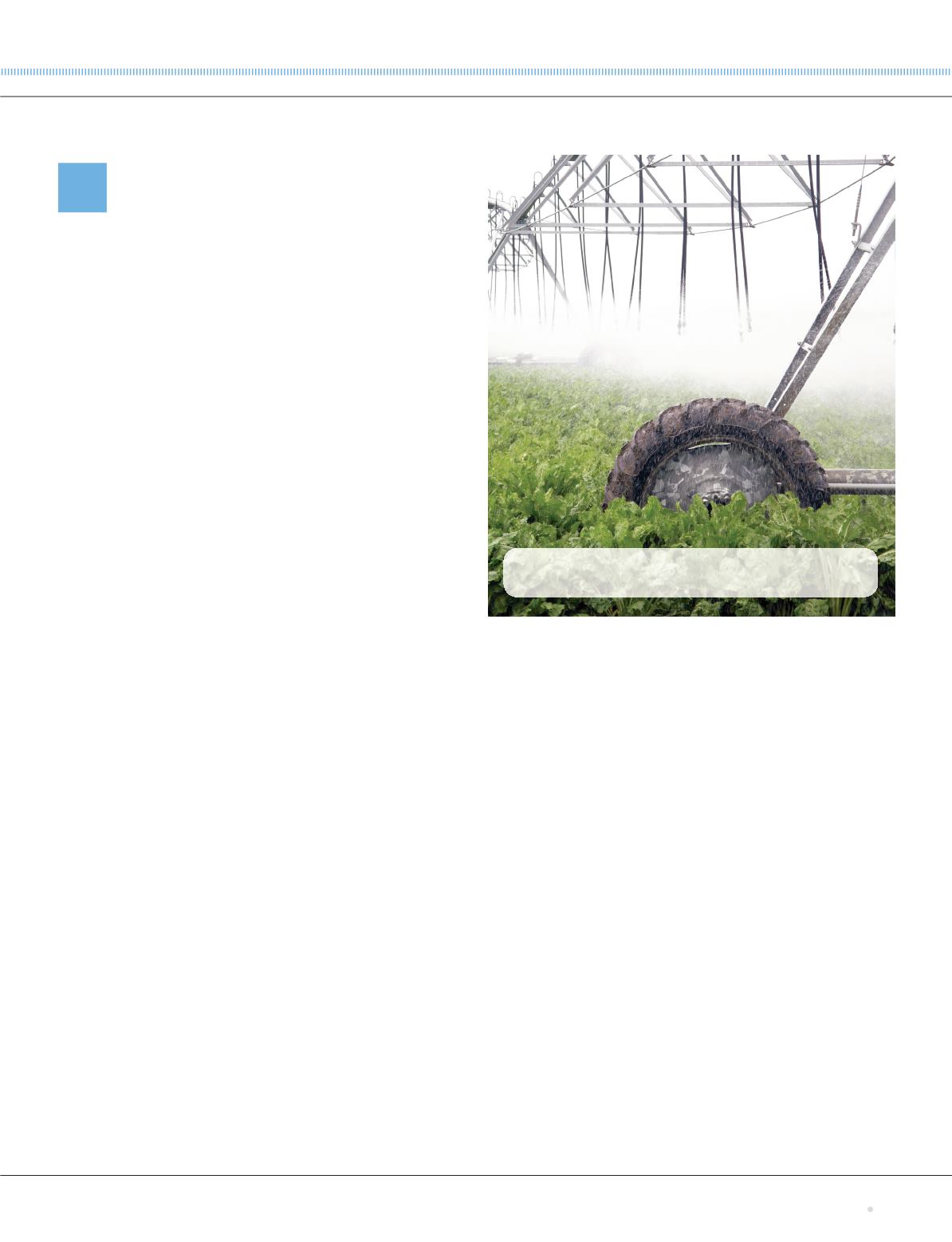
The Food Issue
2015
grainswest.com
19
OU’RE CRAVING A COOL DRINK ON A HOT DAY.
You go into your kitchen, turn on the faucet, and there
it is—pure, free-flowing, seemingly endless water. In
any modern home, it’s a convenience so basic we don’t even
think of it as a source of security.
That sense of security, born of a certainty nearly as deep as
the certainty that our next inhalation will pull oxygen into our
lungs, is rooted in the hydrologic cycle—the endless transport
of water around the world, from oceans to mountains to rivers
and back to sea.
On the Canadian Prairies, our water comes from rain, snow
and the vast snow packs of the Rockies. Water evaporated
from the oceans falls on mountaintops, where it freezes in
winter, then melts in the spring and summer, cascading down
the rough hillsides to collect in streams that merge into rivers.
In these rivers, it flows out across the land, cleaned by riparian
areas rich in plant and animal life. Municipalities divert some
of it, treating it and delivering it through an immense system of
pipes to your home.
After you’re finished with it, the water leaves your home
through an equally immense waste system to treatment
facilities where it is cleaned. From there, it is returned to the
rivers, where it rejoins the flow to the oceans—which ocean
depends on where you live. If you’re an Edmontonian, your
water comes from the North Saskatchewan River and returns
to Hudson’s Bay. In similar fashion, if you live in Calgary,
drawing your next drink from the Bow River, the water leaving
your home also returns to the Hudson.
Many water experts think that our faith in the endlessness
of that cycle, its invariance, is misplaced. Robert Sandford,
Epcor water security research chair at the United Nations
University, has been thinking a lot about the mistakes that
sense of security leads to: “We are beginning to realize that
we have accepted and encouraged wasteful water use as
a social norm. We have, at enormous cost, overbuilt water
infrastructure to support that wasteful norm. Now we find
we cannot afford to maintain and replace the entire overbuilt
infrastructure that supports that waste, which increases the
risk of public health disasters like [the E. coli outbreak in]
Walkerton [Ontario].”
That complacency and sense of security, and the wasteful
choices it has led to, will soon require us to rethink how we
manage our most precious resource. As we look ahead to
the rest of the 21st century, we can start to see the shape of a
long-lasting disruption coming—a change in the whole water
cycle itself. To begin to understand what that would mean in
the future, it’s important to understand how we currently use
water in Alberta.
OIL AND WATER
Urban users are allocated roughly 11 per cent of Alberta’s
water resources for their homes, lawns, gardens and pools.
Many would guess that the province’s famous (even infamous)
oil and gas industry uses much of the rest. To free up the 168
billion barrels of extractable oil in northern Alberta, the third-
largest reserves in the world, takes roughly three barrels of
water for each barrel of oil produced. Water is used to boil the
sand, allowing the heavy bitumen to rise to the top; to cool the
massive machinery; and to make hydrogen and oxygen for a
range of other industrial chemical uses. However, the oil and
gas industry accounts for only about six per cent of the annual
water allocation in the province.
The majority of Alberta’s water—60 to 65 per cent of all
water consumed in the province on average—is used to
irrigate more than 625,000 hectares of agricultural land.
Irrigation is vital to agriculture in many areas and Alberta is
an irrigation powerhouse, encompassing 65 per cent of
Canada’s irrigated land area. Irrigation is also tremendously
productive—while less than six per cent of cultivated land in
the province is irrigated, nearly 20 per cent of Alberta’s gross
agricultural production comes from irrigated land.
Growing crops on irrigated land takes enormous volumes
of clean water. To visualize just how much, picture all the
water needed in a season pooled on the land. The water to
grow spring wheat would be 42-48 centimetres deep, canola
40-48 centimetres deep and potatoes 40-55 centimetres
deep. Imagine that depth of water stretched over the
province’s irrigated land and you can begin to grasp just how
much water needs to be available throughout the year.
Y
Irrigation, which accounts for the majority of the province’s
overall water use, is vital for farmers in southern Alberta.


